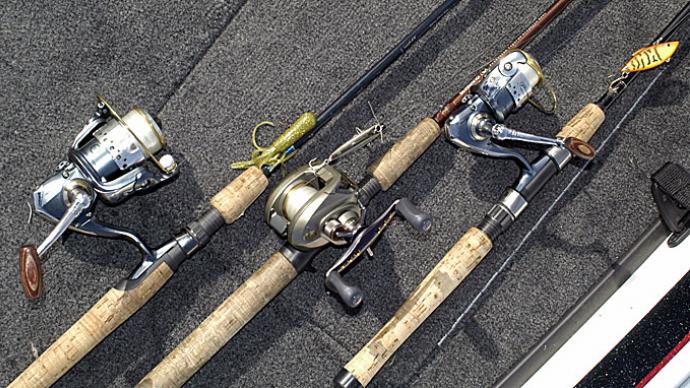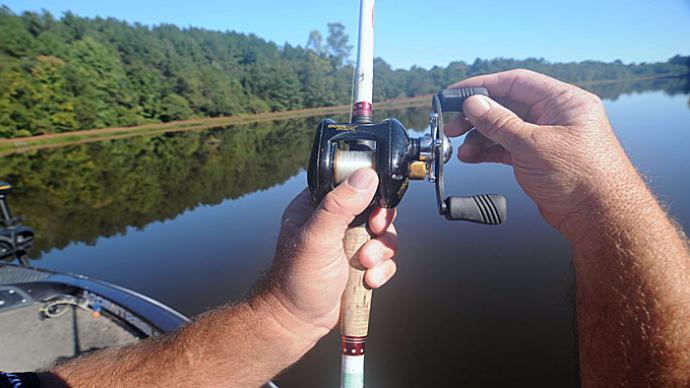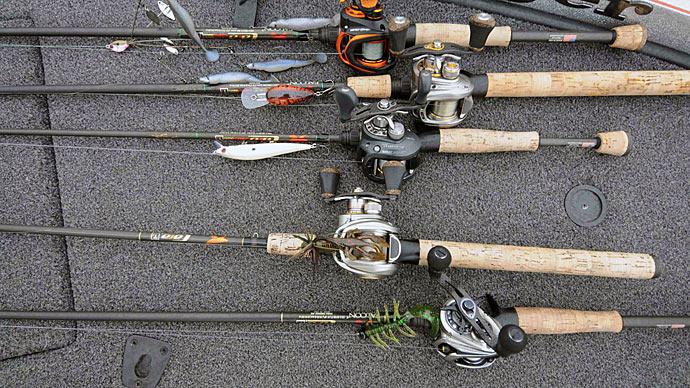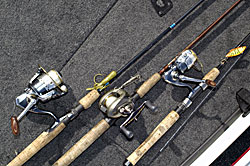
There was a time when the only rod and reel you saw in the hands of bass pros on Saturday morning TV shows was a bait-casting outfit. Times have changed. With the explosion of quality smallmouth waters across the country and the invention of braided lines and finesse techniques that require light line, more and more bass anglers are using spinning gear these days. But there is a time and place for both. Knowing when and why to use a spinning rod and reel or a baitcasting outfit is critical for success.
“To me, spinning reels lend themselves more to finesse techniques like drop shotting, shaky heads, and tubes,” said tournament angler Scott Dobson. “I’m fishing for smallmouths a lot in clear water with light line, which lends itself to spinning tackle. Spinning tackle is perfect for a 6-to 10-pound test line, which I use for smallmouths. Spinning tackle also allows precise casting, and you can pick up line quicker.”
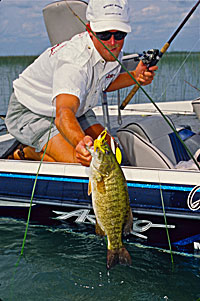
Spinning reels utilize a fixed spool that oscillates during the retrieve, so the line is wrapped evenly on the spool. The line is directed to the spool by the bail spring. During the cast, the weight and launch of the lure pull line off the spool in large coils. The line contacts the spool's edge as it comes off the reel. The first guide on a spinning rod, called the collecting or choking guide, gathers the line and funnels it along with the blank of the rod and through the remaining guides. The lighter the line you use, the less friction there is with the line contacting the spool and guides and the farther you can cast.
Spinning equipment best suits light lures, and bait-casting gear functions best with heavier lures. “In clear water fishing for smallmouths, I’m generally using 1/16- to ¼-ounce lures, so I tend to use spinning tackle,” Dobson said. “With a baitcaster, I’m going to be using lures that weigh ½ ounce or more. A baitcaster is more of a power setup better suited to ¾ to 1 ounce moving baits, like crankbaits and spinnerbaits, or when you’re forced to use heavier line and fish heavy cover where you need to winch the fish out quickly. With a baitcaster, I’m going to be using anywhere from 14- to 20-pound test if I’m using mono.”
Because you use lighter line when fishing with spinning gear versus baitcasting, spinning rods tend to be longer and more flexible to handle lighter lines. The guides on a spinning rod are bigger in front of the reel, get progressively smaller, and have a longer foot to reduce friction and keep the line away from the blank to prevent line slap when casting. Casting rods might have a slightly larger first guide, but the remaining guides are generally the same size and closer to the blank.
In its most primitive form, the most crucial feature of a spinning reel is the spool. I was fishing a river once and saw some migrant workers fishing down from me. I saw no fishing rods, so I began watching them. They would take a pop can that had monofilament wrapped around it, swing a heavy weight with hooks attached around their head, and heave the weight out into the river while at the same time pointing the pop can toward the weight. The line would come off the can like the spool on a spinning reel. They would then prop up the can on a stick and wait for it to start bouncing. Then they would wrap the line back on the can as they pulled in the fish. I’m sure this was how the first Mexican spinning reel was invented.
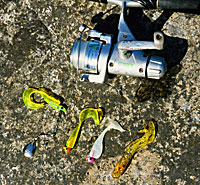
Spinning gear affords the anglers a more comprehensive range of casting motions than a bait-casting outfit. With spinning gear, you can cast overhand, underhand, sidearm, or backhanded, which is a real advantage when you’re trying to flip under a dock or under overhanging limbs and other places you can’t get to with a baitcaster.
Spinning reel users have to contend with two things: line twists and bail springs. Line twists can be attributed to several factors. One reason is the line may have been put on the reel improperly. You have a 50/50 chance of getting it right. When filling a spinning reel, attach the line to the spool and lay the spool of line on the ground, or in a pan of water, with the label up. Make a few turns of the reel handle and then stop. If the line begins to coil off the reel, turn the spool of line over. If it doesn’t, continue to fill the reel to approximately 1/8 of an inch from the rim of the reel spool.
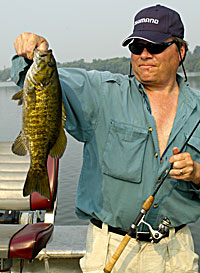
Reeling against the drag is a common cause of line twists. I used to cringe when customers would reel and reel regardless of whether the fish was running, jumping, or not moving. If the line goes out and you continue to reel, the line is being twisted with every turn of the handle. To retrieve line when fighting a fish, lift the rod high and reel it down towards the fish. If the fish runs, stop reeling and let it run before lifting again and reeling down. If your line becomes twisted, try taking the lure off and letting the line spool out behind a moving boat. That will take out the majority of the line twist.
Use a quality, ball-bearing snap swivel when using lures like crankbaits or spinnerbaits on spinning tackle. If you’re fishing tubes, worms, or twisters, consider adding a short shock tippet of heavier fluorocarbon with a barrel swivel to your main line.
Using a braid can also alleviate line twists. “I’ve been frustrated by line twists with spinning reels,” Dobson said. “Braid solved the problem.” Braid has no memory, unlike monofilament or fluorocarbon, and eliminates line twists. The problem with braid in clear water is that it looks like anchor rope. I like Suffix 832 braid and add a clear fluorocarbon leader of 6- or 8-pound test.”
Bails and bail springs can be a nightmare for spinning tackle users. One way to extend the life of the bail spring is to close the bail manually after each cast. Doing so will extend the life of bail springs. It’s easy for bail arms to get bent, so make it a point of storing reels where they’re not likely to get stepped on or somewhere a heavy object might fall on them and bend them. Improvements in bail systems have made bails and springs much more durable in recent years.

The best tip is to buy the best reel you can afford. “You get what you pay for,” Dobson said. “I’m a big fan of Shimano. You'll have fewer problems if you buy a high-end spinning reel, like the Shimano Stradic Ci4+. If you catch a bunch of big smallmouths, it doesn’t take long to blow out the gears of a lesser real.” Dobson likes that the Stradic Ci4+ also has a fast 6:1 gear ratio.
One key to smooth spinning reel operation is maintenance. “With YouTube and other online sites, there are all kinds of tutorials on reel maintenance that you can view,” Dobson advised. “It doesn’t take long before you’re a self-taught reel repair expert. Keeping your spinning reels in tip-top shape is key to making them last and functioning properly when you’re on the water.”
Baitcasters are the workhorse for bass anglers. When it comes time to go toe to toe with big bucketmouths, and you need to winch them out of heavy cover, you want a baitcasting outfit. Baitcasters are perfect for flipping and pitching with heavier lures when you need to set the hook hard a get the fish headed to the boat before it buries itself in the vegetation.
One strong suit of baitcaster is that you can use a heavier line on them. A spinning reel that could accommodate 100 yards of 30-pound test monofilament would be three or four times the size and weight of a bait-casting reel that could hold the same amount of line. The spinning reel will also not function well with the thick, stiff monofilament, but a baitcasting reel will work just fine.
The way the spool revolves and meshes with the gears on a baitcasting reel provides direct power you can’t get with a spinning reel. Drags on baitcasters are consistent, infinitely adjustable, and smooth.
Because of their design, baitcasting reels do not function well with small diameter lines. When pressure is applied to the spool during a retrieve, a smaller-diameter line will cut down into the spool creating a backlash or worse. Consequently, using 20-pound braid is not a good idea on a baitcaster because, in reality, it only has the diameter of 8-pound test mono. The solution is to use an even heavier braid, like 40- or even 80-pound test, with a diameter of 17- to 25-pound monofilament. With that much strength and power, you can hoist the biggest bucketmouth out of a seemingly impenetrable jungle.
Baitcasting reels require a highly trained and educated thumb to avoid backlashes. Modern baitcasting reels are much more user-friendly compared to reels of years past. Innovations, like Daiwa’s T-Wing System and Magforce Z, cast control and make it a chinch to take advantage of a baitcaster’s versatility. And you’ll be casting like a pro in no time.
Spending some money on a quality bait-casting reel is a significant first step. Daiwa’s Zillion TWS or the less expensive Tatula 200 HD, Shimano’s Curado E, or Abu Garcia Revo series are worthwhile investments that will last you a lifetime.
Neither spinning nor baitcasting reels can do it all when it comes to bass fishing. It is best to go armed with both.
BassResource may receive a portion of revenues if you make a purchase using a link above.


